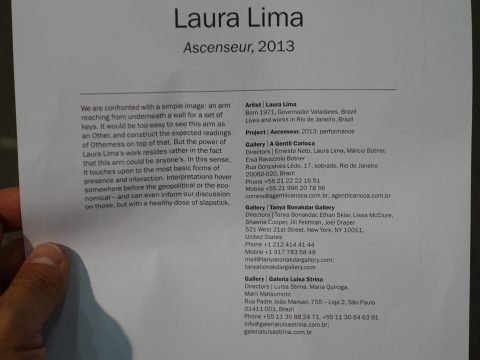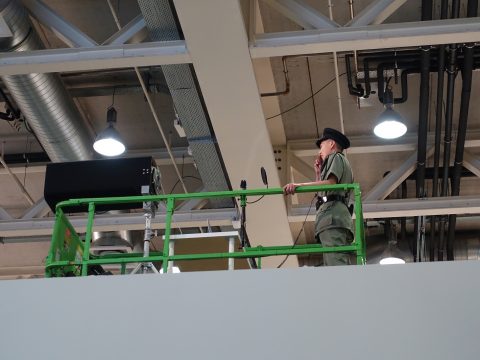Art Basel 2016: a positive reaction to the impossible Brexit
- Art Basel Unlimited 2016.
- Art Basel Unlimited 2016.
- Art Basel Unlimited 2016.
- Art Basel Unlimited 2016.
- Art Basel Unlimited 2016.
- Art Basel Unlimited 2016.
- Art Basel Unlimited 2016.
- Art Basel Unlimited 2016.
- Art Basel Unlimited 2016.
- Art Basel Unlimited 2016.
- Art Basel Unlimited 2016.
- Art Basel Unlimited 2016.
- Art Basel Unlimited 2016.
- Art Basel Unlimited 2016.
- Art Basel Unlimited 2016.
- Art Basel Unlimited 2016.
- Art Basel Unlimited 2016.
- Art Basel Unlimited 2016.
- Art Basel Unlimited 2016.
- Art Basel Unlimited 2016.
- Art Basel Unlimited 2016.
- Art Basel Unlimited 2016.
- Art Basel Unlimited 2016.
- Art Basel Unlimited 2016.
It’s raining in Basel, like last year, and British people, the second art market in the world by value, will soon decide whether to stay in the EU, or to leave it. But if they stay, as most of the opinion makers are suggesting, someone may make a lot of money by betting against the currently too pessimistic European stock markets and that is probably one of the reasons why two out of the three new paintings by Wade Guyton presented today in Basel have quickly been sold during the opening – the one still available is at Petzel gallery, and costs $ 600.000, transport and taxes not included. Assuming that Guyton is for contemporary art produced by mid career artists a sort of cardinal point, as gold or crude oil are for economics, it means that Art Basel is having a quite positive beginning.
The A game called a few days ago by former art journalist Marc Spiegler, the art fair’s director since 2008, is apparently defeating the thin market that has characterized the past months – and all of those who keep an eye open on the auctions still remember the outstanding black Guyton’s estimated between $ 600.000 and 800.000 that went unsold at Sotheby’s just a month ago (wrongly placed at the end of a week of auctions, and among a not exiting set of lots). Here in Basel, probably the strongest art market in Europe, art galleries are effectively doing their best to restore the collectors’ confidence, as clearly proved by this year Unlimited section, one of the most welcoming we have ever seen, despite the new armed security guards at the entrance and the old-fashioned boxes containing introductory writings and details about the works. Considering how ambitious these pieces are – also in terms of price – a step forward in didactic tools is certainly required for the next edition.
The first thing you notice at Unlimited this year is that the artworks have been kept somehow separated, using more closed rooms and white walls in order to give to each piece a specific environment. We would still call it an open space, but now it looks more like a small village, with many one-storey buildings and some nice squares to be discovered along the way. Like the one where the outstanding “Wall” (2010) by El Anatsui is exhibited, and from where you enter the room hosting the immersive video installation by Rafael Lozano-Hemmer e Krzysztof Wodiczko. In the case of Anatsui you immediately start thinking about how long it has taken, and how many human hands have been employed, to collect and put together all those small pieces of aluminium cans and tap bottles. Now that the audience, also thanks to art, is getting more and more confident with African’s contemporary culture and its post-colonial society, this same kind of works are assuming a totally different “specific weight”. On the contrary, Hemmer and Wodiczko surveillance cameras based piece (Zoom pavillion, 2015) talks about the kind of obsession that came from the need of security – do you remember the security armed guards that we mentioned? You could take a selfie, but that is scary.
Laura Lima’s installation seems to walk on the same line. A female arm is trying to reach from underneath a wall a set of keys thrown on the floor. You instinctively help the hand to get them (she would not be able to catch the “keys” without your help). You lightly touch her fingers while giving her the keys. She is talking about help and solidarity, and that is what today possibly marks the difference between the art coming from the so-called developed societies and from the developing ones. As a matter of fact extra USA/UK art is generally warmer, politically involved, somehow more human than the one produced in the emerged areas of A(r)tlantis.
Let’s take, for instance, the eye catching total grey “Collector’s House” by Hans Op de Beeck, representing the lofty environment surrounding someone who can afford a baby grand piano, a huge library, an indoor pond with water lilies, and of course, beautiful works of art, that in this case could be also regarded as quite provoking half dressed women. That Johann Joachim Winckelmann’s neoclassical “quite simplicity” is definitely lost also in the politically correct installation by Elmgreen and Dragset, just a few steps from the Collector’s House. Two invisible auctioneers are selling at invisible buyers some invisible pieces of art (Secondary, 2015). Similar pieces are presented in the convincing installation by Davide Balula (Mimed scultpures, 2016). In this case the “absent” pieces are by Henry Moore, David Smith, Barbara Hepworth, Eva Hesse, Tony Smith, Alberto Giacometti, Louise Bourgeois. What this group of pieces have in common is not said, but we would notice that all them are actionable ones.
Grey is also the colour chosen by emerging Lebanese artist Rayyane Tabet for his “The dead sea in three parts”. It embodies the volumes of waters of the Dead Sea given to Jordan, Israel and Palestine by the United Nation Partition Plan of Palestine approved after the Second World War. The Jordan part remains upright, while the two other sides collapse to the floor. But as far as we know that would be a too provoking piece of art in the grey collector’s room. A place where all the colours would certainly be better.
June 15, 2016


































